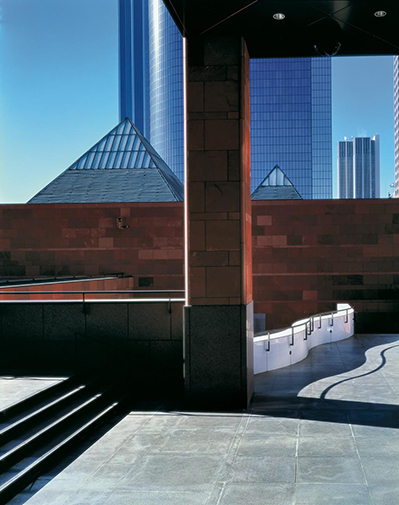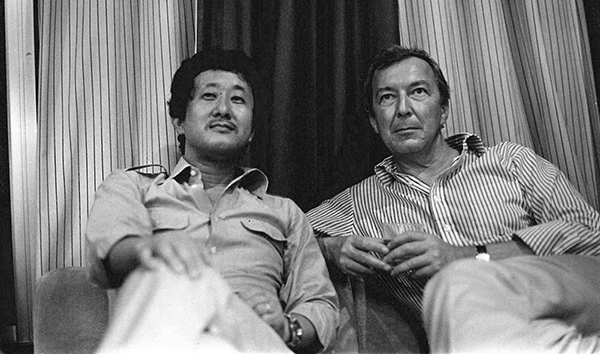2019 프리츠커상 이소자키 아라타 수상
LA현대미술관(MOCA)의 건축가 이소자키 아라타(磯崎新·87)가 건축계의 노벨상으로 불리우는 2019 프리츠커상을 수상했다. 이로써 일본 출신 건축가는 안도 다다오 등 8명에 이르렀다.
Arata Isozaki Receives the 2019 Pritzker Architecture Prize
He surpasses the framework of architecture to raise questions that transcend eras and borders.
Chicago, IL (March 5, 2019) – Arata Isozaki, distinguished Japanese architect, city planner and theorist, has been selected as the 2019 Laureate of the Pritzker Architecture Prize, the award that is known internationally as architecture’s highest honor.
Lauded as a visionary amongst his international contemporaries, Isozaki’s forward-thinking approach, deep commitment to the “art of space,” and transnational methodology have been evidenced since the 1960s. The prolific architect has been credited with facilitating dialogue between East and West, reinterpreting global influences within architecture, and supporting the development of younger generations in the field. His precision and dexterity are demonstrated through his mastery of an intercontinental range of building techniques, interpretation of site and context, and intentionality of details.
The 2019 Jury Citation states, in part, “Possessing a profound knowledge of architectural history and theory, and embracing the avant-garde, he never merely replicated the status quo, but his search for meaningful architecture was reflected in his buildings that to this day, defy stylistic categorizations, are constantly evolving, and always fresh in their approach.”
Isozaki’s early successes in architecture transpired during the era following the Allied occupation of Japan, when the country sought to rebuild itself after the ruins of the Second World War. “I wanted to see the world through my own eyes, so I traveled around the globe at least ten times before I turned thirty. I wanted to feel the life of people in different places and visited extensively inside Japan, but also to the Islamic world, villages in the deep mountains of China, South East Asia, and metropolitan cities in the U.S. I was trying to find any opportunities to do so, and through this, I kept questioning, ‘what is architecture?’,” recalls the Laureate.
Not only did he extend efforts to physically reconstruct his native hometown with buildings including Ōita Medical Hall (1959-60) and Annex (1970-1972 Ōita, Japan), and the Ōita Prefectural Library (1962-1966 Ōita, Japan, renamed Ōita Art Plaza in 1996), but also redefined mutual exchange between eastern and western societies, allowing Japanese vision to inform European and American design, particularly in the 1980s.

MOCA Los Angeles, photo courtesy of Yasuhiro Ishimoto
“Isozaki was one of the first Japanese architects to build outside of Japan during a time when western civilizations traditionally influenced the East, making his architecture—which was distinctively influenced by his global citizenry—truly international,” comments Tom Pritzker, Chairman of Hyatt Foundation. “In a global world, architecture needs that communication.”
His buildings appear geometrically simple, but are infused with theory and purpose. The Museum of Contemporary Art, Los Angeles (1981-1986 Los Angeles, United States) was the architect’s first international commission. Though controversial and geographically challenging, the red Indian sandstone building was resolved by Isozaki’s eloquent awareness of scale through an assemblage of volumes, while employing the golden ratio and yin yang theory throughout, evoking the complementary nature of western and eastern relationships.
Isozaki’s avant-garde approach is fluid, adjusting in response to the needs and influences of each environment through a concept of interrelated time and form called “ma.” Thoughtful connectivity between global universality and local identity is made apparent through his comprehensive cross-cultural and interdisciplinary solutions that reflect deep sensitivity to specific contextual, environmental and societal needs. Ceramic Park Mino (1996-2002 Gifu, Japan), a ceramics museum situated in a cascading valley, preserves surrounding vegetation while serving as an extension of the topography through outdoor terraces, observation decks and overlooks, detailed with regional stoneware bricks and ceramic. Palau Sant Jordi (1983-1990 Barcelona, Spain), designed for the 1992 Summer Olympic Games, is positioned partially below ground to minimize the profile of the 17,000-person facility and instead highlight the surrounding Montjuïc hillside. The domed roof was built referencing Catalan vault techniques, while the sloped forms were inspired by those of Buddhist temples, and local materials including brick, tile, zinc and travertine were used as finishes.

화가 재스퍼 존스와 이소자키 아라타. Isozaki and Jasper Johns (photo courtesy of Shigeo Anzai)
“Isozaki is a pioneer in understanding that the need for architecture is both global and local—that those two forces are part of a single challenge,” says Justice Stephen Breyer, Jury Chair. “For many years, he has been trying to make certain that areas of the world that have long traditions in architecture are not limited to that tradition, but help spread those traditions while simultaneously learning from the rest of the world.”
The Jury also notes the Laureate’s spirit of generosity, as he has, and continues, to promote architects at the onsets of their careers who have since gone on to become distinguished figures within the discipline.
Isozaki’s work has thus far surpassed six decades and over one hundred built works throughout Asia, Europe, North America, the Middle East and Australia. Other prominent works include the Kitakyushu City Museum of Art (1972-1974 Fukuoka, Japan), Tsukuba Center Building, (1979-1983 Ibaraki, Japan), Art Tower Mito (1986-1990 Ibaraki, Japan), Nara Centennial Hall (1992-1998 Nara, Japan), Pala Alpitour (2002-2006 Torino, Italy), Himalayas Center (2003-2013 Shanghai, China), Allianz Tower (2003-2014 Milan, Italy), Qatar National Convention Center (2004-2011 Doha, Qatar), and Shanghai Symphony Hall (2008-2014 Shanghai, China).
Isozaki is the 46th Laureate of the Pritzker Prize, and the eighth to hail from Japan. The 2019 Pritzker Prize ceremony will take place in France this May, accompanied by a public lecture in Paris.
역대 프리츠커상 수상 건축가 Pritzker Architecture Prize Winners
Arata Isozaki 2019 Laureate
Balkrishna Doshi 2018 Laureate
Rafael Aranda, Carme Pigem & Ramon Vilalta 2017 Laureates
Alejandro Aravena 2016 Laureate
Frei Otto 2015 Laureate
Shigeru Ban 2014 Laureate
Toyo Ito 2013 Laureate
Wang Shu 2012 Laureate
Eduardo Souto de Moura 2011 Laureate
Kazuyo Sejima and Ryue Nishizawa 2010 Laureates
Peter Zumthor 2009 Laureate
Jean Nouvel 2008 Laureate
Richard Rogers 2007 Laureate
Paulo Mendes da Rocha 2006 Laureate
Thom Mayne 2005 Laureate
Zaha Hadid 2004 Laureate
Jørn Utzon 2003 Laureate
Glenn Murcutt 2002 Laureate
Jacques Herzog and Pierre de Meuron 2001 Laureates
Rem Koolhaas 2000 Laureate
Norman Foster 1999 Laureate
Renzo Piano 1998 Laureate
Sverre Fehn 1997 Laureate
Rafael Moneo 1996 Laureate
Tadao Ando 1995 Laureate
Christian de Portzamparc 1994 Laureate
Fumihiko Maki 1993 Laureate
Alvaro Siza 1992 Laureate
Robert Venturi 1991 Laureate
Aldo Rossi 1990 Laureate
Frank Gehry 1989 Laureate
Gordon Bunshaft 1988 Laureate
Oscar Niemeyer 1988 Laureate
Kenzo Tange 1987 Laureate
Gottfried Böhm 1986 Laureate
Hans Hollein 1985 Laureate
Richard Meier 1984 Laureate
I.M. Pei 1983 Laureate
Kevin Roche 1982 Laureate
James Stirling 1981 Laureate
Luis Barragán 1980 Laureate
Philip Johnson 1979 Laureate





 마스터오브와인(MW) 세계 384명, full list
마스터오브와인(MW) 세계 384명, full list

